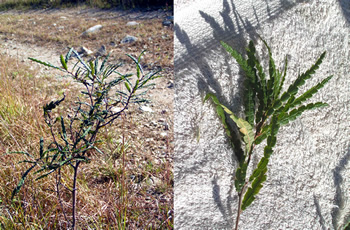Sweet Fern: Keep Bugs Away and Berries Fresh
Sometimes it is interesting to research some of the very common species which we see every day and think nothing of. One of these is sweet fern. It is easily found in Sharon wherever there is some clear, sunny space with sandy soil. Sweet fern, comptonia peregrina, is not a true fern. It is actually a deciduous shrub growing from 2 to 4 ft tall. It is also known as meadow fern, shrubby fern, sweet bush, ferry bush, and spleenwort bush. It is a very hardy plant if growing in its preferred conditions and soil.
 Sweet fern piqued my interest one day when my wife and I were hiking and having problems with mosquitoes and some insects which I call “head bumper bugs” — flies that hone in on your head but which don’t seem to bite. (I think they are some sort of black fly.) My wife, a true New Englander, suggested that I should crush and rub some sweet fern on my neck. It worked. It was amazingly effective! Ever since, I seek out a patch of sweet fern before going into the woods.
Sweet fern piqued my interest one day when my wife and I were hiking and having problems with mosquitoes and some insects which I call “head bumper bugs” — flies that hone in on your head but which don’t seem to bite. (I think they are some sort of black fly.) My wife, a true New Englander, suggested that I should crush and rub some sweet fern on my neck. It worked. It was amazingly effective! Ever since, I seek out a patch of sweet fern before going into the woods.
If camping, throw some sweet fern on the fire. The smoke will drive away bugs. It can almost always be found somewhere on the forest edge.
While sweet fern’s taste is definitely not sweet, it gives off an aromatic smell much like sweet hay. Leaves can be harvested in early summer and dried for later use.
This very common plant has further uses. If you have picked berries or fruit, a sweet fern lining in your container will keep them fresh much longer. If you wander into poison ivy, boil some water and add washed leaves of sweet fern. Steep for a few minutes and strain well. Apply this over the affected area. It is reportedly very effective.
Sweet fern has been used by Native Americans as a general tonic tea. Stronger decoctions have been used for rheumatism, internal bleeding, leucorrhea, dysentery, and topical astringent:
“Sweet fern was employed medicinally by several native North American Indian tribes, who used it especially as a poultice to treat a variety of complaints. It is still used for most of the same purposes in modern herbalism.”—Plants for a Future
